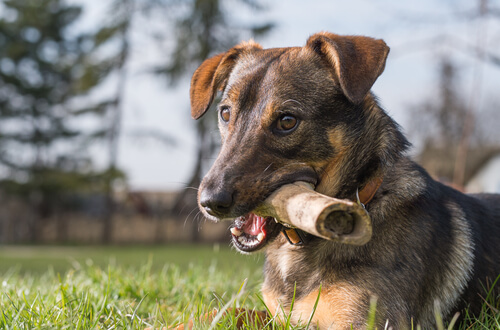Dog Bones - Are They Safe for Your Pet?

There are many theories on whether you should give your dog bones. While many strongly recommend against it, others believe there’s no real harm in it. Some believe that only certain types should be avoided, like chicken bones. But what is the answer to this contentious question?
While bones might be one of the most nutritious and popular dog treats, there’s no denying they can be dangerous. Not even experts are willing to be entirely dogmatic (if you’ll pardon the pun) about this issue, and there doesn’t seem to be a simple yes or no answer.
Let’s take a look at the dangers of dog bones, so that you can make an informed decision. That way, if you decide to give your dog bones, you’ll know which are best.
Why are bones dangerous to dogs?

These are some of the dangers of dog bones:
- They can wear down their teeth, and even cause them to break, which is extremely painful for your dog.
- They can hurt their tongues, the roof of their mouth, and even cause sores and ulcers.
- If the bone your dog is playing with starts to splinter, it can actually perforate their esophagus. If this happens, they might even need surgery.
- Instead of biting them into smaller pieces, many dogs swallow their bones whole. Doing this could kill them. A piece can easily get stuck in their intestine, blocking their digestive tract and causing severe pain. It can even cause an infection that can require the removal of part of the colon.
Obviously, just because there are risks, doesn’t mean these things happen to every dog. If you still want to give your dogs bones in spite of the dangers, you need to know which to choose, and which to avoid.
Which bones can you give your dog?

In spite of all the myths surrounding chicken bones, this is actually the type that is easiest for your dog to digest. Plus, they are full of nutrients and minerals such as calcium.
It’s important to remember that dogs’ jaws and digestive system are designed for eating things like bones. As a result, chicken, rabbit, lamb and ham bones are all suitable for dogs, as long as you follow a few pieces of advice.
Some final advice
- They shouldn’t be the main part of their diet. Just because your dog can eat bones, doesn’t mean they should have them every day. They should only be given as a treat, and should only form a small part of their diet.
- Give them raw bones. Cooked bones are more likely to splinter and have been known to cause injuries. So, if you want to give them chicken, or any other type of bones, they should always be raw. Forget that classic film scene where the character eats a roast chicken leg and throws the bone to their faithful canine companion.
- Size matters. You need to think about the size of your dog, as well as the size of the bone, and pick their treat accordingly. If you have a small dog, choose one of the smaller ones (still making sure to buy raw bones) or chicken cartilage treats. If you have a large dog, you should buy chicken legs or ham hocks, which are much bigger, making them tastier, and easier to chew and digest.
- Don’t give bones to old dogs. You also need to think about how old your dog is. Just as you wouldn’t give one to a puppy in case it hurt itself, you also shouldn’t give bones to older dogs. Teeth and digestive systems weaken as they get older, so bones pose more dangers to them than younger dogs.
Whatever you decide, be careful about giving your dog bones. And if you decide not to give your dog bones at all, then that is also a perfectly valid decision.
There are many theories on whether you should give your dog bones. While many strongly recommend against it, others believe there’s no real harm in it. Some believe that only certain types should be avoided, like chicken bones. But what is the answer to this contentious question?
While bones might be one of the most nutritious and popular dog treats, there’s no denying they can be dangerous. Not even experts are willing to be entirely dogmatic (if you’ll pardon the pun) about this issue, and there doesn’t seem to be a simple yes or no answer.
Let’s take a look at the dangers of dog bones, so that you can make an informed decision. That way, if you decide to give your dog bones, you’ll know which are best.
Why are bones dangerous to dogs?

These are some of the dangers of dog bones:
- They can wear down their teeth, and even cause them to break, which is extremely painful for your dog.
- They can hurt their tongues, the roof of their mouth, and even cause sores and ulcers.
- If the bone your dog is playing with starts to splinter, it can actually perforate their esophagus. If this happens, they might even need surgery.
- Instead of biting them into smaller pieces, many dogs swallow their bones whole. Doing this could kill them. A piece can easily get stuck in their intestine, blocking their digestive tract and causing severe pain. It can even cause an infection that can require the removal of part of the colon.
Obviously, just because there are risks, doesn’t mean these things happen to every dog. If you still want to give your dogs bones in spite of the dangers, you need to know which to choose, and which to avoid.
Which bones can you give your dog?

In spite of all the myths surrounding chicken bones, this is actually the type that is easiest for your dog to digest. Plus, they are full of nutrients and minerals such as calcium.
It’s important to remember that dogs’ jaws and digestive system are designed for eating things like bones. As a result, chicken, rabbit, lamb and ham bones are all suitable for dogs, as long as you follow a few pieces of advice.
Some final advice
- They shouldn’t be the main part of their diet. Just because your dog can eat bones, doesn’t mean they should have them every day. They should only be given as a treat, and should only form a small part of their diet.
- Give them raw bones. Cooked bones are more likely to splinter and have been known to cause injuries. So, if you want to give them chicken, or any other type of bones, they should always be raw. Forget that classic film scene where the character eats a roast chicken leg and throws the bone to their faithful canine companion.
- Size matters. You need to think about the size of your dog, as well as the size of the bone, and pick their treat accordingly. If you have a small dog, choose one of the smaller ones (still making sure to buy raw bones) or chicken cartilage treats. If you have a large dog, you should buy chicken legs or ham hocks, which are much bigger, making them tastier, and easier to chew and digest.
- Don’t give bones to old dogs. You also need to think about how old your dog is. Just as you wouldn’t give one to a puppy in case it hurt itself, you also shouldn’t give bones to older dogs. Teeth and digestive systems weaken as they get older, so bones pose more dangers to them than younger dogs.
Whatever you decide, be careful about giving your dog bones. And if you decide not to give your dog bones at all, then that is also a perfectly valid decision.
This text is provided for informational purposes only and does not replace consultation with a professional. If in doubt, consult your specialist.








